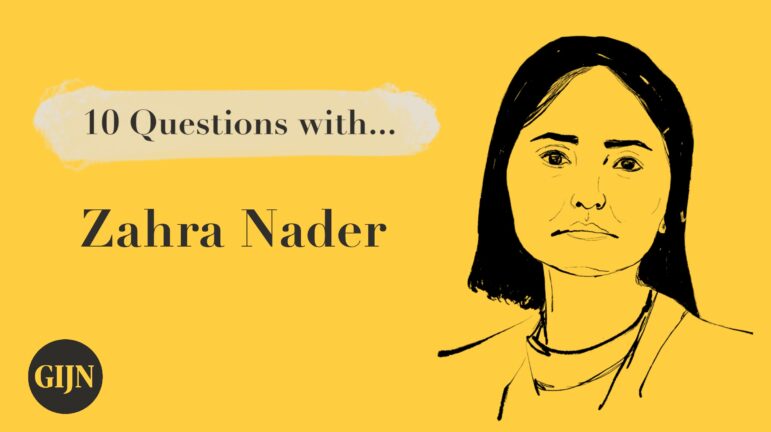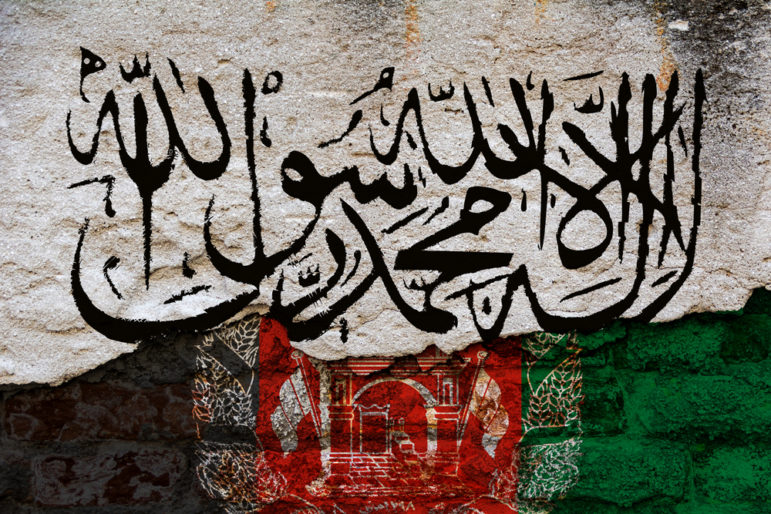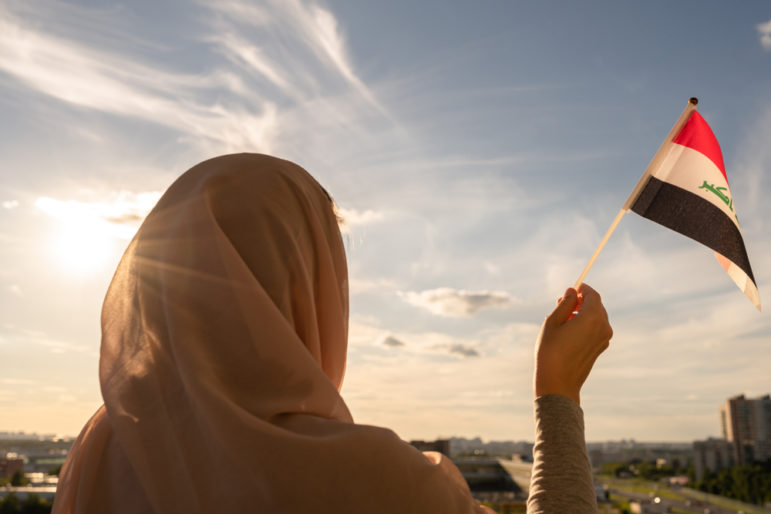

Illustration: Smaranda Tolosano for GIJN
Reporting and Sharing Women’s Stories in the Face of Taliban Oppression
Read this article in
In August 2021, the Taliban seized control of Afghanistan two decades after being removed from power.
Since the takeover, women have been banned from working most government jobs, ordered to cover their bodies and faces and advised to stay at home, prohibited from using gyms and parks, and from attending high school and college. Earlier this year, a representative for the UN in Kabul labeled Afghanistan the most repressive country in the world for women.
Reporting on women’s experiences in Afghanistan and the impact of the Taliban on their lives and rights has never been harder. But motivated rather than deterred by the challenge, Afghan journalist and former reporter for the New York Times’ Afghanistan bureau Zahra Nader launched Zan Times a year after the Taliban’s takeover.
A newsroom that covers women’s and marginalized communities’ rights in Afghanistan is a way to resist, says Nader, who chose the Farsi word for women, “Zan,” for the name of her news site to denote its focus.
Although she was no longer based in Afghanistan when the Taliban seized control, Nader and other exiled colleagues felt a responsibility to act from the outside to investigate issues affecting women in their home country and raise their voices. The team has conducted investigations into the murders and disappearances of protesters by the Taliban, forced marriages, and the lives of Afghanistan’s Kuchis or nomadic women.
To cover these stories, Zan Times works with two groups of Afghan journalists: one group inside the country and a group of editors who are mostly in exile. Having women journalists on the ground is crucial for building trust with sources, many of whom are scared of recrimination if they talk about the Taliban.
The security and safety of the 12-strong team is of the utmost concern. For contributors in Afghanistan, pen names are used on stories and they work in isolation, not connected to their colleagues within Afghanistan or sharing their work with family and friends to prevent the network from being traced through an individual.
GIJN: Of all the investigations you’ve worked on, which has been your favorite and why?
Zahra Nader: In August, we published an eight-month investigation in partnership with the Fuller Project and the Guardian about how more women in Afghanistan are taking their own lives than men.
We gathered data from 11 out of 34 provinces in Afghanistan under the Taliban, who are trying to suppress any source of information, especially any information that might cast them in a negative light. It has been very difficult for us to obtain this data and that’s why it has taken eight months.
We used a grassroots approach where we went to sources [in the provinces] — some of the sources knew us so it was much easier to convince them that their identity would be protected. Other sources didn’t know us from before, so we had to establish that connection and trust. That trust was two-fold: we wanted the source to trust us to be able to share information; and we wanted to be able to trust that the source is not working with the Taliban and is not sharing information that a journalist is looking into suicide data.
People are not very willing to speak about suicide. It’s considered un-Islamic and is stigmatized, so working on this kind of story is very hard. I’m so proud that our team was able to do this difficult work and to show the impact of the Taliban’s policies on women in Afghanistan.
GIJN: What are the biggest challenges in terms of investigative reporting in the country?
ZN: I think being an investigative journalist is difficult anywhere in the world, but with the Taliban in power, it’s very, very hard in Afghanistan. Before, when we were doing investigative journalism, there were difficulties trying to dig for information, but the government was a source. You could interview people and ask for specific data. They might not share it with us, but it wasn’t the case that we’d be scared to ask the question.
One of the first things the Taliban did was to create 11 rules for journalism, some of which are very vague, such as not to cover anything that is contrary to Islam or Afghan culture. There is no definition of what is considered contrary to Islam, Afghan culture, or the Afghan national interest. That’s scary for any journalist to work with.
We are scared of the Taliban stopping us and finding our colleagues during an investigation, which makes it very hard. There are topics that the Taliban don’t want covered and we have been able to cover those because we have trust. Journalists who have roots in the community encourage [sources] to open up and share stories because they know if the story gets out there might be a change. Unfortunately, there has not been enough change, because of the authorities. Every day they are creating policies that cut more rights and oppress the population.
GIJN: What’s been the greatest hurdle or challenge that you’ve faced in your time as an investigative journalist?
ZN: The challenge of working in Afghanistan for me has been that I’m a woman and have always been denied opportunities because of my gender. There was a lot of discrimination based on my ethnicity as a Hazara woman, but also on my gender. In most of the newsrooms I worked in, I was the only woman. I was seen as a troublemaker because I was not silent, and asked for my rights. I needed to speak up and create a space where other women could work.
I have battled most of the time to prove myself. In one newsroom, a colleague told me that I could never be a good journalist, saying [because I was a woman] that I could not go out, stay late in office, cover attacks, or travel. I was never asked to do any of those things because, as a woman, they assumed I couldn’t do them. When I joined The New York Times, I felt I had to prove what we can do as women journalists. I was always volunteering to cover attacks, to stay late, whatever it took for me to prove that I was as capable as any male journalist in Afghanistan.
Watch Nader discuss in a GIJC23 panel how women investigative reporters can overcome obstacles and stereotypes.
GIJN: What is your best tip or trick for interviewing?
ZN: Make the person comfortable. For example, I don’t jump into my questions right away, I like to have a chat first. If I know them personally, I start by asking about their life so they feel grounded and comfortable talking with me and then I start talking about the topic.
When I’m talking to a vulnerable group, I want to give them a say. If I notice that they are having a hard time talking to me, I will say: “If this is an uncomfortable topic for you, if there’s something that you don’t feel okay sharing, please don’t feel under pressure.” I let them know they can pass on a question or share as much as they feel comfortable, so they never feel they are being pressed to answer a question.
GIJN: What is a favorite reporting tool, database, or app that you use in your investigations?
ZN: I frequently use social media for my investigations because sometimes it’s very hard to find people. For example, if something happens in a province where I don’t have any sources, I go to social media, type the name of the province and see who is interacting.
There was a story being reported that a woman had been beheaded by the Taliban. She was a volleyball player and her death was reported widely in the media. The story didn’t feel credible to me because the only source was a former volleyball coach who gave no information about how she was killed. Very basic information about what happened to this woman was missing. I needed to speak with her parents or somebody who could verify some of the information.
I searched her name online and found an announcement [a death notice for family members] had been posted on Facebook. Her in-laws were the organizers, so I found their phone numbers. Then I found her brother, her father, and her profile on Facebook and could see who had commented on her Facebook. I talked to her family and got the whole story: she was not killed by the Taliban.
GIJN: What’s the best advice you have received, and what words of advice would you give an aspiring investigative journalist?
ZN: One of the best pieces of advice I’ve received is to pay attention to detail. When I was working with The New York Times and would read the work of my colleague Mujib Mashal, there were a lot of details that hit me [in his work]. It is so useful to be able to collect these small details and put them into your stories.
GIJN: Who is a journalist you admire, and why?
ZN: There are a lot of journalists whose work I like, but, to name just one, it would have to be Mujib Mashal. I like his work because of how he crafts his stories. I remember one of his stories where a man’s hands were tied, but he included that they were tied with a red scarf. Ever since working with him, I always try to focus on the details.
GIJN: What is the greatest mistake you’ve made and what lessons did you learn?
ZN: An error that I have made is jumping into working on a story before researching it. That has happened several times and I’ve learned now that I have to do more research before starting the actual work of reporting the story.
GIJN: How do you avoid burnout in your line of work?
ZN: I am not a good person to answer that question, because I have suffered [from burnout] a lot. What I find helpful is that once I finish the work, I am hopeful about the results it’s going to bring and the changes, and I know I have done my best. This makes me feel a little bit better and helps me to recover from some of those burnouts. And dancing — when I’m stressed I put on my headphones and dance, dance, dance.
GIJN: What about investigative journalism do you find frustrating, or do you hope will change in the future?
ZN: What frustrates me with being an investigative journalist is that you work a lot — it can be very difficult to finish an investigation — and you hope that something comes out of it, that something happens because of this story. Most of the time, nothing changes and that frustrates me. I hope we can do more work that will lead to changes even though the changes are gradual. It’s realizing that my story will not change anything, but the second, third, or fourth one might. It can just be very frustrating when it feels like nothing is happening.
 Laura Oliver is a freelance journalist based in the UK. She has written for the Guardian, BBC, Euronews, and others. She is a regular journalism trainer for the Thomson Foundation and Thomson Reuters Foundation and works as an audience strategy consultant for newsrooms. You can find her work here.
Laura Oliver is a freelance journalist based in the UK. She has written for the Guardian, BBC, Euronews, and others. She is a regular journalism trainer for the Thomson Foundation and Thomson Reuters Foundation and works as an audience strategy consultant for newsrooms. You can find her work here.









